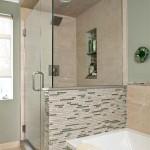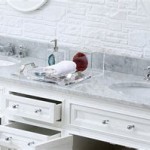Tin Bathroom Sinks: A Comprehensive Guide
Tin bathroom sinks offer a distinctive aesthetic and practical functionality that can enhance the overall design of a bathroom. This article explores the characteristics, advantages, disadvantages, maintenance, and design considerations associated with tin bathroom sinks, providing a comprehensive overview for homeowners and designers considering this unique material.
Tin, as a material for bathroom sinks, presents a departure from more common choices like porcelain, stainless steel, or stone. Its inherent properties, coupled with specialized crafting techniques, result in sinks that possess a visual warmth and tactile quality often absent in other materials. Understanding the nuances of tin as a sink material is crucial for informed decision-making.
Aesthetic Properties and Design Versatility
One of the primary draws of tin bathroom sinks is their distinctive aesthetic. The metal's natural hue leans towards a soft, warm gray, often exhibiting subtle variations that contribute to its unique character. This color palette allows tin sinks to seamlessly integrate into a range of bathroom styles, from rustic and farmhouse to modern and industrial. The inherent malleability of tin also enables designers to create sinks in a variety of shapes and sizes, from simple rectangular basins to more elaborate, sculpted designs.
The surface texture of a tin sink can further enhance its aesthetic appeal. Texturing techniques such as hammering, embossing, and etching can be employed to create visual interest and add depth to the sink's surface. These techniques not only contribute to the sink's aesthetic value but also provide a tactile experience that elevates the user's interaction with the fixture. The ability to customize the surface finish allows for a high degree of personalization, enabling homeowners to create a bathroom space that reflects their individual style.
Tin's compatibility with other materials further expands its design versatility. It pairs well with natural materials like wood and stone, creating a sense of warmth and organic beauty. It also complements more modern materials such as glass and concrete, adding a touch of rustic charm to contemporary designs. The adaptability of tin makes it a suitable choice for a wide range of bathroom aesthetics, allowing designers to create cohesive and visually appealing spaces.
Furthermore, tin can be treated to achieve different finishes. A polished finish provides a sleek, modern look, while a brushed finish offers a more rustic and understated appearance. Patinas can also be applied to create an aged, weathered look, adding character and charm to the sink. The ability to alter the finish of a tin sink provides further flexibility in design, allowing it to be tailored to specific aesthetic preferences.
Durability, Maintenance, and Environmental Considerations
The durability of tin bathroom sinks is often a key consideration for prospective buyers. While tin is a relatively soft metal compared to materials like stainless steel or cast iron, properly crafted tin sinks can provide years of reliable service. The key to ensuring durability lies in the quality of the tin used and the craftsmanship of the sink. Thicker gauges of tin are generally more resistant to dents and scratches, while skilled fabrication techniques ensure that the sink is structurally sound and resistant to leaks.
Maintaining a tin bathroom sink is relatively straightforward, but it does require some understanding of the material's properties. Unlike porcelain or stainless steel, tin is susceptible to etching from acidic substances. Therefore, it is important to avoid using harsh cleaning products or abrasive scrubbers. A mild soap and water solution, applied with a soft cloth, is typically sufficient for routine cleaning. Regular cleaning helps to prevent the buildup of soap scum and other residues that can dull the sink's finish.
Specialized tin cleaners are available for more stubborn stains or discoloration. These cleaners are formulated to be gentle on the metal and avoid causing damage to the finish. It is important to follow the manufacturer's instructions carefully when using these cleaners. Regular waxing with a specialized tin wax can also help to protect the sink's surface and maintain its luster. The wax creates a protective barrier that prevents water spots and other stains from penetrating the metal.
From an environmental perspective, tin is a relatively sustainable material. It is naturally abundant and can be recycled without significant loss of quality. The energy required to produce tin is also lower than that required for some other metals, such as aluminum. Choosing a tin sink made from recycled materials can further minimize its environmental impact. Additionally, the longevity of tin sinks reduces the need for frequent replacement, contributing to a more sustainable lifecycle.
However, the extraction and processing of tin can have environmental consequences. Mining activities can disrupt ecosystems and pollute water sources. It is important to choose tin sinks from manufacturers who adhere to responsible sourcing practices and prioritize environmental sustainability. Certifications such as the Responsible Minerals Initiative can provide assurance that the tin used in the sink has been sourced ethically and sustainably.
Installation and Cost Considerations
The installation of a tin bathroom sink is generally similar to that of other types of sinks. However, due to the metal's relative softness, extra care must be taken to avoid scratching or denting the sink during installation. It is recommended to use soft cloths or padding to protect the sink's surface during handling and installation. Additionally, the sink should be properly supported to prevent it from sagging or warping over time.
The cost of tin bathroom sinks can vary widely depending on the size, design, and quality of the sink. Simple, mass-produced tin sinks may be relatively affordable, while custom-designed or handcrafted sinks can be significantly more expensive. The cost of the sink should be considered in relation to its aesthetic value, durability, and environmental sustainability. Investing in a high-quality tin sink can provide years of enjoyment and contribute to the overall value of the bathroom.
When comparing the cost of tin sinks to that of other materials, it is important to consider the long-term costs of ownership. While tin sinks may require more specialized cleaning and maintenance than some other materials, their durability and longevity can offset these costs over time. Additionally, the unique aesthetic and design versatility of tin sinks can add significant value to the bathroom, making them a worthwhile investment for homeowners who appreciate their distinctive qualities.
The installation cost can also vary depending on the complexity of the installation and the plumber's fees. Before purchasing a tin sink, it is advisable to obtain quotes from several plumbers to get an estimate of the installation cost. This will help to ensure that the overall cost of the project is within budget. It is also important to ensure that the plumber is experienced in installing tin sinks, as improper installation can damage the sink and void the warranty.
In conclusion, tin bathroom sinks offer a unique blend of aesthetic appeal, durability, and environmental sustainability. By understanding the properties of tin and the considerations associated with its use in bathroom sinks, homeowners and designers can make informed decisions that enhance the beauty and functionality of their spaces.
Selecting the right tin sink requires careful consideration of several factors, including the desired aesthetic, the level of maintenance required, and the overall budget. With proper care and maintenance, a tin bathroom sink can provide years of reliable service and add a distinctive touch of elegance to any bathroom.
The growing awareness of environmental sustainability has also contributed to the increasing popularity of tin bathroom sinks. As consumers become more conscious of the environmental impact of their purchasing decisions, they are increasingly drawn to materials like tin that are both durable and recyclable. This trend is likely to continue in the coming years, further solidifying the position of tin as a viable and attractive material for bathroom sinks.
Ultimately, the decision of whether or not to install a tin bathroom sink is a personal one. However, by carefully considering the factors outlined in this article, homeowners and designers can make informed choices that enhance the beauty, functionality, and sustainability of their bathroom spaces.

Bucket Sinks Design Ideas Pictures Remodel And Decor Rustic Bathroom Vanities Laundry Rooms Best

Metal Sink

Tin Bucket Love 5 Diy Ideas Craftsman Bathroom Farmhouse Sink Vanity

Handmade Rustic Bathroom Vanity 60 Dual Sink Designs Vanities

Galvanized Metal Bathroom Mirror Design Ideas

Metal Bathroom Sinks New Sink Design Wave By Reginox

Metal Bathroom Vanities Pottery Barn

Bathroom Vanity Metal Brass Wall Mounted Sink Remodeling Diy Projects

Bc Designs Copper 530mm Countertop Sink With Inner Tin Outer Buy At Bathroom City

Tin Bucket Sink Rustic Bathroom Sinks Bathrooms







